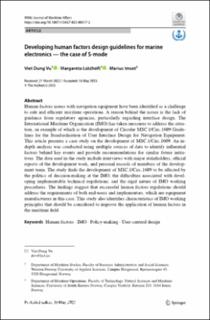| dc.contributor.author | Vu, Viet Dung | |
| dc.contributor.author | Lützhöft, Margareta Holtensdotter | |
| dc.contributor.author | Imset, Marius | |
| dc.date.accessioned | 2024-01-08T13:43:18Z | |
| dc.date.available | 2024-01-08T13:43:18Z | |
| dc.date.created | 2023-06-05T14:15:40Z | |
| dc.date.issued | 2023 | |
| dc.identifier.citation | Vu, V. D., Lützhöft, M., & Imset, M. (2023). Developing human factors design guidelines for marine electronics — the case of S-mode. WMU Journal of Maritime Affairs. | en_US |
| dc.identifier.issn | 1651-436X | |
| dc.identifier.uri | https://hdl.handle.net/11250/3110406 | |
| dc.description.abstract | Human factors issues with navigation equipment have been identified as a challenge to safe and efficient maritime operations. A reason behind the issues is the lack of guidance from regulatory agencies, particularly regarding interface design. The International Maritime Organisation (IMO) has taken measures to address the situation, an example of which is the development of Circular MSC.1/Circ.1609 Guidelines for the Standardisation of User Interface Design for Navigation Equipment. This article presents a case study on the development of MSC.1/Circ.1609. An in-depth analysis was conducted using multiple sources of data to identify influential factors behind key events and provide recommendations for similar future initiatives. The data used in the study include interviews with major stakeholders, official reports of the development work, and personal records of members of the development team. The study finds the development of MSC.1/Circ.1609 to be affected by the politics of decision-making at the IMO, the difficulties associated with developing implementable technical regulations, and the rigid nature of IMO working procedures. The findings suggest that successful human factors regulations should address the requirements of both end-users and implementors, which are equipment manufacturers in this case. This study also identifies characteristics of IMO working principles that should be considered to improve the application of human factors in the maritime field. | en_US |
| dc.language.iso | eng | en_US |
| dc.relation.uri | https://doi.org/10.1007/s13437-023-00317-2 | |
| dc.rights | Navngivelse 4.0 Internasjonal | * |
| dc.rights.uri | http://creativecommons.org/licenses/by/4.0/deed.no | * |
| dc.title | Developing human factors design guidelines for marine electronics — the case of S-mode | en_US |
| dc.type | Peer reviewed | en_US |
| dc.type | Journal article | en_US |
| dc.description.version | publishedVersion | en_US |
| dc.rights.holder | © The Author(s) 2023. | en_US |
| dc.source.pagenumber | 24 | en_US |
| dc.source.journal | WMU Journal of Maritime Affairs (JoMA) | en_US |
| dc.identifier.doi | https://doi.org/10.1007/s13437-023-00317-2 | |
| dc.identifier.cristin | 2151936 | |
| cristin.ispublished | true | |
| cristin.fulltext | original | |
| cristin.qualitycode | 1 | |

